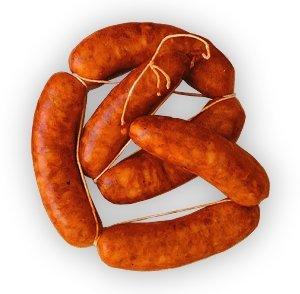 Q: First of all, how do you correctly pronounce the word 'Chorizo'?
Q: First of all, how do you correctly pronounce the word 'Chorizo'?
A: I hear so many different pronunciations and spellings of this word - probably more than any other. The standard Castilian way would be 'choritho' with a 'ch' from 'church' and a 'th' from think. For South American Spanish and some regional accents, substitute the 'th' for an 's'.
Q: Starting with the basics - what exactly is it?
A: It's basically a cured pork sausage flavored with a few particular herbs and spices, most importantly 'pimenton' (smoked Spanish paprika) which gives it its distinctive flavor. If it's made with spicy pimenton then the result is obviously a spicy chorizo.
Q: There seem to be so many types of chorizo, run us through the main varieties.
A: There a quite a few variables to consider when buying chorizo: spicy or not, curation time, shape, quality, brand etc.
Q: What's the main consideration?
A: The most important distinction is whether you want it for cooking or immediate slicing. For slicing, you need a fully cured sausage, that's to say with 30 days or more curation. For cooking, a softer fresher sausage is more appropriate. You can buy them fully fresh in Spain, but most will have a small amount of curation, usually between 7 (probably referred to as fresh still) and 14 (often called 'semi-cured') days. This is just to develop a good flavour before cooking.
Q: What about shape - is that important?
A: Traditionally, chorizo is made in either hoops ('herradura') or strings of 5-10 small sausages ('achorizado' or 'corra') - the latter is more usual for cooking chorizo whilst the former is generally used for cured sausages for slicing. You also see chorizo in larger, thicker sticks, often in deli counters (called 'cular' or 'vela') - these are made largely for slicing by machine and produce nice slices for sandwiches or appetizer plates.
Q: And quality and brand - isn't that a matter of taste?
A: Yes and no. Obviously, people will prefer some brands over others, but it is important to note that brands are just that - the name of the manufacturer. Importers often get asked for chorizo 'Revilla' by customers who have seen the name and assume that it refers to the type of product. Revilla is the name of just one (large) manufacturer - there are many others. Quality can again depend on brand, but most factories produce two distinct quality grades referred to as 'Extra', the higher quality product made from prime cuts of pork, and 'Primera', the lower quality variety made from 'less than prime' cuts.
Q: Anything else worth knowing?
A: There are a couple of other points. Chorizo 'ahumado' (smoked) is sometimes found, but it should noted that normal chorizo is definitely NOT smoked (although the paprika used to make it is). Smoked chorizo has a much stronger flavour that you either love or hate. You will also see Chorizo Iberico on sale, which is made from the same black-footed pigs as Jamon Iberico, the gourmet (and extremely expensive) Spanish ham. This type of chorizo has, again, a stronger flavor.